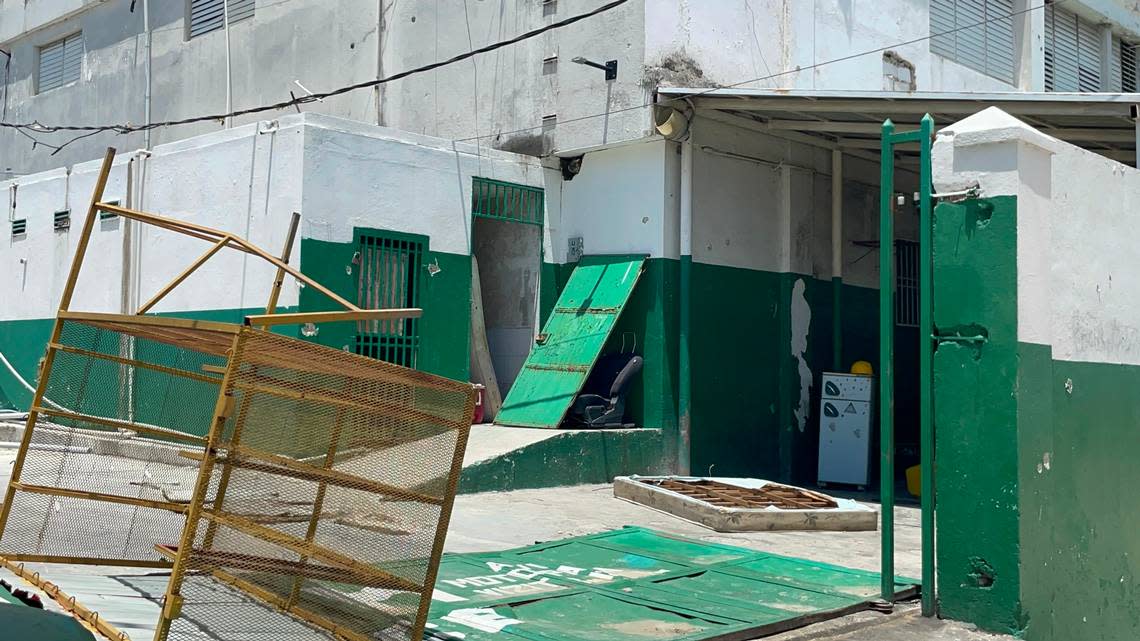Video shows Haiti’s largest public hospital, which has been ravaged by gangs

Bullet holes pockmark the walls. Burned vehicles straddle the sidewalk. The gigantic green iron gates that once controlled the entrance now litter the ground.
On the other side of the green-and-white walls of the Hospital of the State University of Haiti, known as the General Hospital, what hasn’t been stolen or burned by gangs has been left to bake in the scorching sun.
Haiti’s largest public hospital, once teeming with poor patients in its bare wards and merchants on its broken sidewalks, is now a lifeless shell of its former self in a deserted downtown Port-au-Prince.
The reign of terror launched by armed gangs over the last four-and-a-half months has not only pushed Haiti’s already struggling public health system to the brink of collapse, it has turned downtown Port-au-Prince into a war zone where garbage piles the streets, and abandoned homes and burned out pharmacies now adorn the landscape.
Two days after Haiti Prime Minister Garry Conille visited the General Hospital, there is still no sign of when — or if — operations can resume, leaving thousands of poor Haitians already struggling to find care with even fewer options.
The executive director of the hospital, Dr. Jude Milcé, told the Miami Herald that he still needs to do an evaluation of the facility to see how much damage was done by gangs to both the current structure and the new 534-bed replacement facility being built behind it by the governments of France and the United States. Milcé was not part of the prime minister’s visit and despite a request to the police department a week earlier to take him and a representative of the French Development Agency to the site, he still hasn’t had access, he said.
A spokesperson with the U.S. Agency for International Development, which is helping rebuild the General Hospital along with the French government, said the medical facility, which collapsed in the 2010 earthquake, is “critical to providing modern health care services for Haiti’s population, particularly those who cannot afford private health care.”
“The United States is deeply concerned about the impact the country’s recent violence has had on the Haitian people, including its impact on Haitians’ ability to access health care services. The violence has prevented medical staff from adequately staffing facilities and has limited facilities’ ability to operate due to scarcity of fuel and medical supplies,” the spokesperson said.
Before the recent increase in gang violence, it is estimated the General Hospital served nearly 220,000 patients annually, USAID said, adding that construction of the new facility “had been intermittent for a number of reasons including insecurity and a shortage of fuel and materials.”
Like representatives of French Agency for Development, USAID, which provides close to 25% of all healthcare spending in Haiti, has yet to have access to either the old hospital site or the new construction to evaluate what it will take for either to be operational.
On Thursday, a Miami Herald journalist visited the area and found the hospital an empty husk, with an empty street in front of the once crowded medical facility. There was none of the sporadic gunfire that had made the area a high-security risk as gangs sought to take control of the nearby National Palace, but the atmosphere was still one of unease. Other than an armored police car patrolling the area, there was no visible sign of a police perimeter suggesting that heavily armed security forces now control the area, which also includes the nearby National Penitentiary that gangs raided on March 2 and 3 to release thousands of prisoners.
Despite Haitian police’s triumphant declaration this week that they have resumed control of the hospital from powerful armed gangs, the area surrounding it remains an almost ghost-town.
Earlier this week, the former director of the National Solid Waste Management Service, Magalie Habitant, took credit for cleaning up parts of downtown and inside the hospital as part of an initiative she said is meant to bring people back to the city center.
Speaking to journalists on Thursday, Habitant said she wants “everyone who has left the area” to return.
“The people whose homes were destroyed, let’s come back and clean them up so we can give life to the area,” she said of Haitians who have been forced to leave their homes and who now number around 578,000, according to the United Nations.
As head of garbage collection under late President Jovenel Moïse, Habitant endured her own share of criticism for the mounting trash on Haiti’s streets. Now, she insists it is a public health hazard.
“When there is garbage... it is not good because the odor isn’t good for you. We are saying down with the garbage,” she said.
For months, neither police no residents have had access to parts of Port-au-Prince, 80% of which remains under the control of armed groups..
As she spoke to reporters Thursday, Habitant’s corps of volunteers could be seen sweeping sidewalks and shoveling dirt, all while wearing black T-shirts with Garry Conille=Security+Elections in white letters.
Fritzner Elva, a Port-au-Prince resident and one of the volunteers, said while some are criticizing the initiative as a political stunt by Habitant, it’s an effort to get people to return to the area.
“We are telling the population that the work isn’t the work of Magalie Habitant alone because Haiti isn’t only for Magalie Habitant. Haiti is for all of us,” he said.
Just days ago, he said, the area was deserted. Now, life is timidly returning.
“We are sending a message to the people who used to sell in front of the General Hospital, come help us cleanup, throw out what’s no longer good, so that we can have another life,” Elva said. “When you look here, you see motorcycles have started to pass, when you look, you see a few buses; for us to accomplish this, we all have to come together.”

